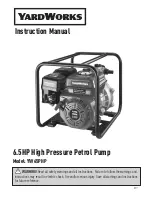
9
Pressure Switch Circuit
The defrost control incorporates a pressure switch circuit that
allows the application of an optional high pressure switch. See
“Defrost Control Board” in “Adjusting Defrost System.” During a
demand cycle, the defrost control will lock out the heat pump if
the optional high pressure switch opens. The diagnostic LEDs will
display a pattern for an open high pressure switch. See
“Diagnostic LEDs” in “Troubleshooting the Defrost System.”
The heat pump will remain locked out until the switch resets or is
reset.
Remove the factory-installed jumper before connecting the
optional high pressure switch to the control board.
NOTE: If not using a pressure switch, the factory-installed jumper
wire must be connected.
Adjusting Defrost System
Defrost Control Board
Optional high pressure switch safety circuit connections
NOTE: To add the pressure switch, remove the factory-installed
jumper.
Adjust Time Between Defrost Cycles
1. Disconnect power.
2. Remove the control box cover.
3. Adjust the time period between defrost cycles by placing the
defrost time plug in the proper position. See “Defrost Control
Board.”
■
For 30-minute intervals between defrost cycles, move the
Defrost Time Setting Plug to the pins corresponding
to 30.
■
For 60-minute intervals between defrost cycles, move the
Defrost Time Setting Plug to the pins corresponding to
60 (this setting is the factory preset setting).
■
For 90-minute intervals between defrost cycles, move the
Defrost Time Setting Plug to the pins corresponding
to 90.
4. Replace the control box cover.
5. Reconnect power.
A. Defrost interval timing pins
B. Test pins
C. Compressor delay pins
D. Reversing valve
E. Low pressure switch
F. Defrost thermostat
G. High pressure switch (optional)
H. Diagnostic LEDs
I. 24V terminal strip connections
K1 Relay
K2 Relay
FAN
DS1
L
24V
P2
P5
O-OUT
DF
Y1-OUT
HI-PS
U1
U2
DS2
K3 Relay
P6
TST PS DF C
R
O Y1
C5
LO-PS
C2
P1
30
60
90
TEST
W1
C
L
R
Y1
O
H
I
A
B
C
D
E
F
G
WARNING
Electrical Shock Hazard
Disconnect power before servicing.
Replace all parts and panels before operating.
Failure to do so can result in death or electrical shock.






























